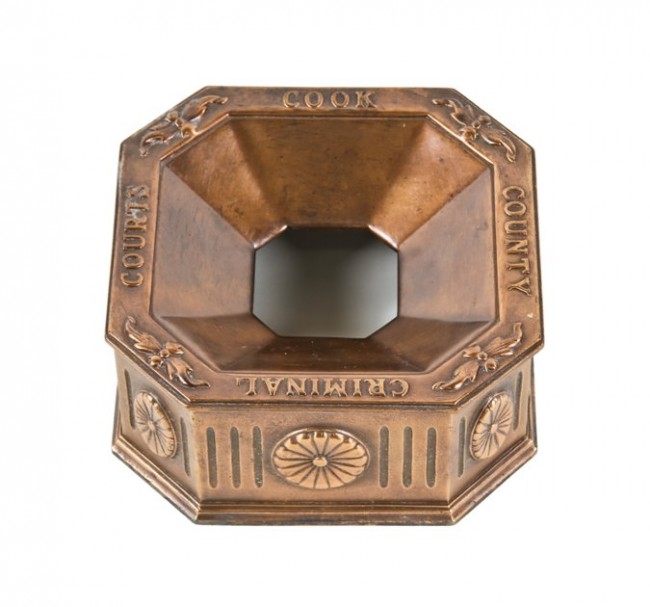
c. 1920’s american antique neoclassical style solid ornamental cast bronze cook county criminal courts building spittoon or cuspidor with nicely aged patina – hall, lawrence & ratcliffe, architects
51-16688-13
Category
Chicago BuildingsAbout This Item
original and intact late 1920’s ornamental cast bronze metal cuspidor or spittoon salvaged from the extant cook county criminal courts building, located in chicago, il. the neoclassical style multi-faceted floor spittoon is comprised of an angled top section contain deeply embossed lettering and floral motifs along the outer edges. the supporting base is accentuated with floral rosettes alternating with vertical grooves. nicely aged and mostly uniform surface patina throughout. the exact bronze metal fabricator is not known. in the late 19th century united states and australia spittoons became a very common feature of pubs, brothels, saloons, hotels, stores, banks, railway carriages, and other places where people (especially adult men) gathered. brass and/or bronze was the most common material for spitoons. other materials used for mass production of spittoons ranged from basic functional iron to elaborately crafted cut glass and fine porcelain. at higher class places like expensive hotels, spittoons could be elaborately decorated. spittoons are flat-bottomed, often weighted to minimize tipping over, and often with an interior “lip” to make spilling less likely if they tip. some have lids, but this is rare. some have holes, sometimes with a plug, to aid in draining and cleaning. use of spittoons was considered an advance of public manners and health, intended to replace previously common spitting on floors, streets, and sidewalks. many places passed laws against spitting in public other than into a spittoon. boy scout troops organized campaigns to paint “do not spit on the sidewalk” notices on city sidewalks. in 1909 in cincinnati, ohio, scout troops together with members of the anti-tuberculosis league painted thousands of such messages in a single night. spittoons were also useful for people suffering from tuberculosis who would cough up phlegm. public spittoons would sometimes contain a solution of an antiseptic such as carbolic acid with the aim of limiting transmission of disease. with the start of the 20th century medical doctors urged tuberculosis sufferers to use personal pocket spittoons instead of public ones; these were jars with tight lids which people could carry with them to spit into. similar devices are still used by some with tuberculosis. after the 1918 flu epidemic, both hygiene and etiquette advocates began to disparage public use of the spittoon, and use began to decline. chewing gum replaced tobacco as the favorite chew of the younger generation. cigarettes were considered more hygienic than spit-inducing chewing tobacco. while it was still not unusual to see spittoons in some public places in parts of the us as late as the 1930’s, vast numbers of old brass spittoons met their ends in the scrap drives of world war ii. the cook county jail and court house and/or criminal courts building (known in chicago as simply “26th and cal”) is encompassed by a large complex of buildings covering nearly a square mile on the west side of chicago. the most significant building (from an architectural standpoint), was designed by architects hall, lawrence & ratcliffe (also designed chicago stadium) and opened in 1929. a neo-classical design clad in bedford limestone, the towering façade is dominated by eight massive doric columns topped by intricately carved figures representing law, justice, liberty, truth, might, love, wisdom & peace. when the jail opened, it was thought to house the largest concentration of prisoners, including al capone and john wayne gacy to name a few.






